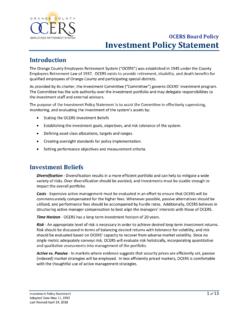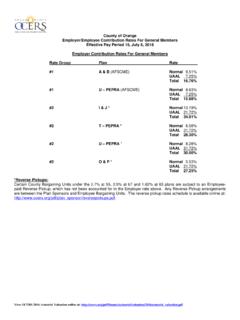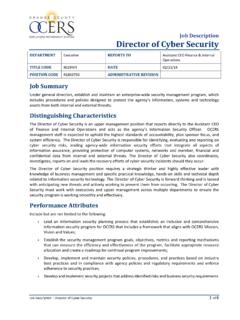Transcription of Economic Dashboards - OCERS
1 2017 OCERS Economic Dashboards20112011 June 28, 2017 The information in this document does not constitute a recommendation to buy or sell securities or any investment recommendation. The contentsof this document have been prepared solely for the OCERS Board and is meant to provide general information only. The information containedherein has been obtained from sources that we believe to be reliable, but its accuracy and completeness are not guaranteed. Any examples shownin this document are purely hypothetical and have been included for demonstrational purposes only. 2017 OCERS Cycle Factor Class Dashboards2 OCERS provides copies of its Economic Dashboards to other public pension plans as a professional courtesy without representation or warranty.
2 This information is not to be construed as investment advice. Commercial use of this material is expressly prohibited. OCERS assumes no liability for the accuracy of the information Cycle Dashboards 2017 OCERS Business Cycle: economy, growth slowed in Q14 Peak?We are Cycle:A recession is considered to have occurred after 2 consecutive quarters of negative GDP growth. A recovery is defined as theperiod when the GDP level rebounds off the trough until it achieves the prior output peak. GDP growth beyond the prior output level isconsidered an expansion. A full business cycle is considered a round trip from one peak to the next, or one trough to the real GDP rose by during the 1stquarter compared to growth in the 4thquarter.
3 This was the slowest quarterly expansionin three years as weak auto sales and depressed utility costs dragged down consumer spending. Consumer spending, representing 70% of theeconomy, only grew in the 1stquarter, the slowest pace since 2009. Economic growth in the 2ndquarter will be dependent on wage gainsin order to help boost sentiment and offset the negative effects on consumer spending from higher inflation. Year over year GDP growth camein at vs in the 4Q 2016. Fed policy makers indicated at their May meeting that they are inclined to ignore transitory weakness inthe 1stquarter and continue normalizing interest rates at their June GDP indicates that the current business cycle has lasted for 111months and remains in the expansion stage.
4 The prior peak occurredduring 4Q07, and the last trough occurred during 2Q09 after GDP output had fallen by nearly $640 billion. The recovery took 2 years andofficially ended when GDP surpassed $15 trillion during June2011. From the last peak the economy has grown by per year, but since thetrough it has expanded by annually in real terms. The last 3 recoveries have lasted 92 months (1982 1990), 120 months (1991 2001), and73 months (2001 2007).Source: Bloomberg/ Federal Reserve Bank of St. Louis, Real Gross Domestic Product (GDPC1)US Real GDP January 2006 to March 2017 Source: Bloomberg & National Bureau of Economic Research: (1/15/2013)Dec 2007 Peak $ $ 2009 Trough$ 2017 OCERS Leading and Coincident Indicators: Continued optimismLeading and Coincident Economic index:The Commerce Department produces indexes of Economic growth, including a coincident index which measures the current state of the economy, aleading indicators series which tends to presage GDP trends, and a lagging index which is a rear view mirror.
5 Most people watch the leading indicatorsfor signals of what is to come. The coincident indicators tend to top out when a recession begins and bottom out when the recession ends, and theleading indicators tend to precede those points by several months. A sharp decline in the leading indicators is almost always bad news for the stockmarket; partly because stock prices themselves are part of the leading indicators index which makes its predictive power less valuable for :The index of leading indicators rose in April after increasing in March. Year over year it has gained 8 out of the 10indicators were positive, with the indicators for building permits and stock prices detracting.
6 The April results suggest that the economy should continueto expand at a moderate pace. The coincident indicator (red line) rose % in April (to from ). The leading indicator (blue line) rose to February from in Conference Board Leading and Coincident Indicators10 years, monthly as of April 30, 2017 Source: Bloomberg/ Conference Board5 Leading Economic Index (LEI)1. Avg. weekly hours, manufacturing2. Avg. weekly initial claims, unemployment insurance3. Manf. new orders: consumer goods, materials4. ISM new orders index5. Manf. new orders: nondefense capital goods ex aircraft6. Building permits, new private housing units7.
7 Stock prices, 500 common stocks8. Leading Credit Index9. Interest rate spread, 10 year Treasury vs. Fed Funds10. Avg. consumer expectations for business conditionsCoincident Economic Index (CEI)1. Employees on nonagricultural payrolls2. Personal income less transfer payments3. Industrial Production4. Manuf. and trade salesSource: The Conference Board, (1/15/14)Source: Bloomberg 2017 OCERS Consumer Confidence: Cooled further in MayTrends:Consumer confidence fell to in May after reporting (revised) in April. The consumer expectations for the next six monthsalso fell to in May from in April. Consumer sentiment cooled further in May from the 16 year high we saw in March.
8 Consumerconfidence remains in healthy territory despite the recent cooling ofthe sentiment. We will continue to closely monitor the direction of thereadings over the next few consumer confidence begins to rise above stall speed , consumers and investors typically begin to engage in irrational behavior, drivingup asset prices beyond reasonable valuation and purchasing beyond their means. We are not there yet, but we are getting : Bloomberg / University of Michigan Consumer ConfidenceMonthly from January 1, 1985 to May 31, 201730 year Average6 Exiting stall speed: irrational behaviorsDoom and GloomSource: Bloomberg 2017 OCERS Fed Guideposts for Unemployment & InflationTrends: The unemployment rate fell to in May from in April,while the labor force participation rate declined slightly andwages failed to meet expectations (falling ).
9 The labor market is showing some slowdown in hiring, but remains healthy overall,supporting the recent interest rate increase by the Fed. The slowdown could be due to a labor shortage where employers find it harder to fillvacancies, but if that is the case , we should expect faster wage growth. We will closely monitor the direction over the next few , the consumer price index (headline inflation) fell in May after it rose in April. The consumer price index rose the past 12 months after rising in April, returning below the Fed s 2% inflation target. Pricesfor energy, transportation, andcommodities contributed the most to the decline in CPI.
10 The core measure rose from the previous month and rose year over year, down from in Unemployment Rate and Consumer Price Index (Urban Consumers)10 years monthly to May 31, 2017 Source: Bloomberg/ Federal Reserve, Bureau of Labor StatisticsInflation Target = : Bloomberg & Federal Reserve 2017 OCERS Fed Forecasts vs. the Futures MarketTarget Federal Funds Rate & 30 day Federal Funds Futures Data Fed dots as of March 2017 & June 2017; Fed funds futures as of June 20178 Source: The Federal Reserve & CME GroupTrends: The update to the fed funds futures market data, the black line (June) vs. the dashed grey line (March), shows that market participants are expecting a slower pace of an increase of the target federal funds rate by the Fed.





